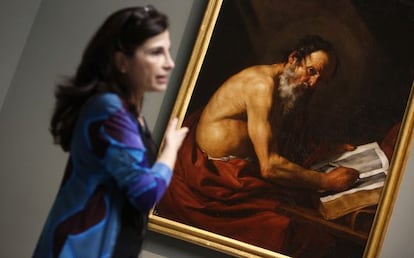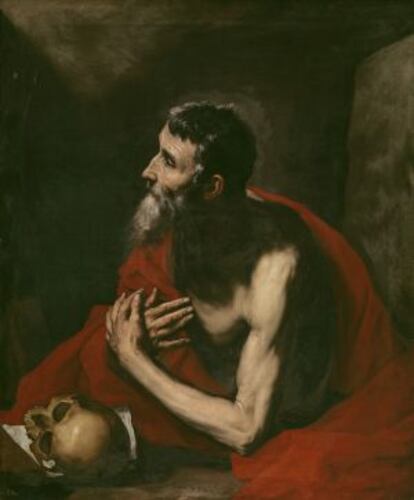New Ribera offers clues to his youth
'Saint Jerome Writing' is now attributed to the Spanish 17th-century painter The Prado Museum is helping clear up doubts about his mysterious early years

His youth has been shrouded in mystery and scholarly controversy. But now, the Prado Museum has taken a step that will help clear the fog of ignorance surrounding the early years of José de Ribera, the 17th-century Spanish painter who was popularly known as Lo Spagnoletto (The little Spaniard) after moving to Italy and pursuing most of his career there.
The Madrid museum has restored Saint Jerome Writing , a painting from 1615 now attributed to Ribera, who was 24 at the time. Before reaching this point, however, the artwork had been attributed to a variety of other artists and had numerous other homes. It is the second early Ribera to hang at the Prado following the gallery's purchase of The Raising of Lazarus at a New York auction for 2.5 million euros in 2001. Saint Jerome Writing , say the Prado experts, provides a window on Ribera's "quality and originality during his early active years, which was a highly singular period in his career."
Until recently, Saint Jerome Writing was kept at the Christopher Columbus museum in Las Palmas de Gran Canaria and was believed to be the work of Valencian painter Esteban March. Before that, it had belonged to the collection of Isabel de Farnesio, the Queen Consort of Spain from 1714 to 1724. By the time the painting first reached the Prado in the 19th century, it was attributed to Massimo Stanzioni, a painter who, like Ribera, was greatly influenced by Caravaggio. From there, it moved on to the Columbus museum in 1940. It was only recently that the Caravaggio expert Gianni Papi identified it as a Ribera, after being alerted by an art specialist.
The expert noted its resemblance to other Ribera paintings from 1615
Papi based his conclusions on the resemblance between the composition and style of this piece and other paintings done by Ribera around 1615. Saint Jerome Writing shares with them "a very Tenebrist use of light" and "great descriptive precision."
"There's the composition, the pictorial structure, the lighting strategy," adds restorer Almudena Sánchez. She explained that when the 158-centimeter-by-98-centimeter oil painting first came to her, it looked "dull and dark" and had sustained damage to its perimeter from moisture and wood-eating insects. Besides that, the layers of varnish had rusted, and were unevenly distributed. Restoring it was a "laborious and delicate" process, she said. The end result is a painting where "we recovered the light that falls down from above, allowing viewers to observe the transitions between light and shadow."
Saint Jerome Writing , which now hangs in a room called " En la senda de Caravaggio " (On the trail of Caravaggio) at the Prado, next to The Raising of Lazarus , also reflects Ribera's own take on the teachings of the Italian master, who is considered the first great Baroque painter.
Javier Portús, chief curator of Spanish painting at the Prado, emphasizes that the painting lets people understand the artist's evolution through the subject matter. There are now over 40 Riberas at the Madrid museum. Besides Saint Jerome Writing , there are two other works on the same subject dating from 1644 and 1652, the year of his death. These two late paintings, says Portús, clearly show "nervous" brush strokes to represent the penitent image of the saint who translated the Bible into Latin, which was very relevant in Catholic countries during the Counter-Reformation of the 16th century.

Starting with this 1615 depiction of Saint Jerome and ending with his two last renditions, Portús notes that "we see a Ribera who is very sensitive to the colors of the Venetians, who progresses towards the expressiveness of color and brush strokes."
Yet the earlier work shows a very different style where individual strokes can barely be made out. This historian stressed the importance of having a new Ribera at the Prado, which considers itself an internationally minded institution. "He was a Spanish painter, but also an Italian one," says Portús. "His work, which influenced the evolution of Spanish 17th-century art enormously, helps us to understand the Spanish school."
Tu suscripción se está usando en otro dispositivo
¿Quieres añadir otro usuario a tu suscripción?
Si continúas leyendo en este dispositivo, no se podrá leer en el otro.
FlechaTu suscripción se está usando en otro dispositivo y solo puedes acceder a EL PAÍS desde un dispositivo a la vez.
Si quieres compartir tu cuenta, cambia tu suscripción a la modalidad Premium, así podrás añadir otro usuario. Cada uno accederá con su propia cuenta de email, lo que os permitirá personalizar vuestra experiencia en EL PAÍS.
¿Tienes una suscripción de empresa? Accede aquí para contratar más cuentas.
En el caso de no saber quién está usando tu cuenta, te recomendamos cambiar tu contraseña aquí.
Si decides continuar compartiendo tu cuenta, este mensaje se mostrará en tu dispositivo y en el de la otra persona que está usando tu cuenta de forma indefinida, afectando a tu experiencia de lectura. Puedes consultar aquí los términos y condiciones de la suscripción digital.








































